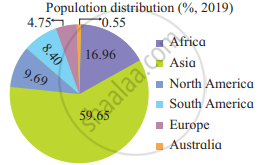Advertisements
Advertisements
प्रश्न
Discuss the factors influencing the distribution and density of population in the world.
उत्तर
The factors influencing the distribution and density of the population in the world may be classified into three broad categories, which may again be divided into minor elements. They are enumerated below.
Geographical factors:
- Availability of water: It is the most critical factor in life. People prefer to live in areas where fresh water is readily available. Water is essential for the development of agriculture and for carrying out day-to-day activities.
- Landforms: People prefer to live in flat plains and gentle slopes as they are favourable for the production of crops and for building roads and industries. The mountainous and uneven terrain offers obstacles in infrastructure development activities that hamper human development and hence are less populated. Eg: Himalayan regions in India.
- Climate: People prefer living in areas that do not have extreme climatic conditions, that is, areas that do not have a high daily and annual range of temperature and adequate rainfall. Eg. Mediterranean regions.
- Soils: Fertile soils are essential for agricultural and allied activities. Therefore, areas with fertile loamy soils have more people living in them as these can support intensive agriculture. Eg. Northern plains.
Economic factors:
- Minerals: Areas rich in minerals attract industries. Mining and allied activities generate employment. Skilled and semi-skilled workers move to these areas, making them densely populated. Eg. Katanga Zambia copper belt in Africa.
- Industrialization: Industrial belts provide job opportunities and attract large numbers of people. These include factory workers, transport operators, shopkeepers, doctors and other professionals.
Eg: The Kobe - Osaka industrial region of Japan. - Urbanization: Better employment opportunities, educational and medical facilities, and better means of transport and communication attract people to cities. It leads to rural-urban migration, and hence cities grow in size.
E.g. prominent, many people move to cities like Delhi, Mumbai, etc., making them densely populated.
Social and cultural factors:
- Some places attract more people because they have religious or cultural significance. In the same way, people tend to move away from areas where there is social and political unrest.
- For example, the emigration of people from civil war affected areas of Africa. The government often incentivises people to live in sparsely populated areas.
E.g. Indira Gandhi Canal colonies.
APPEARS IN
संबंधित प्रश्न
Give a geographical reason:
Population distribution is uneven.
Human factor affecting on the distribution of population is ______.
Complete the chain.
| Sr. No. | A | B | C |
| 1. | Australia | Dense equatorial forest | Highest population |
| 2. | Amazon basin | Coastal region | Sparse population area |
| 3. | East America | Desert | High population |
| 4. | India | Permanently snow covered | No residential population |
| 5. | Antarctica | Monsoon climate | Low density |
Give geographical reason
Population density is a function of population and area of a region
State whether right or wrong:
Land proportion of Asia is least in the world.
State whether right or wrong:
Population density is high in Antarctica
Show the following in the world map. Index is necessary
- Uzbekistan
- The canal which make revolutionary change in ocean transport
- Milan
- Andes mountain
- The country which has highest population
- Industrial city in Europe
- Area of lumbering in Asia
Write short note
Effect of relief on population distribution
Draw diagrams and label it
- Expansive age–sex pyramid
- Circular pattern settlement
- Classification of tertiary economic activities.
Which one of the following states has the highest density of population in India?
Which state of India has the highest population?
The first census of India was held in which year?
How much percent of World’s population is in India?
Write a short note on:
The third stage of population transition theory
Which of the following is not the area of large population concentration?
Which of these factors are responsible for uneven distribution of population in India?
- Climate and terrain
- Development of transport network
- Concentration of natural resources
Consider the following statements and choose the correct option from the given options.
- It is observed that the North Indian Plains, Deltas and Coastal Plains have higher proportion of population.
- The interior districts of central Indian states and Himalayas also have higher proportion of population.
Observe the following diagram and answer the questions given below.
 |
|
- Which continent has the least population?
- Which continent has the least landmass and also the least population?
- Which continent has the most landmass as well as most of the population?
- Which continent is missing in one of the pie charts? Why?
- What is the percentage of population distribution in Asia?
Population distribution is same everywhere.
Analyse the economic factors affecting the distribution of population in the world.
Analyse the social factors affecting the distribution of population in the world.
Draw diagram and label it.
Expansive age – sex ratio.

